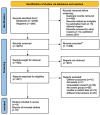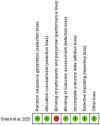High-flow nasal cannula versus noninvasive ventilation in patients with COVID-19: a systematic review and meta-analysis
- PMID: 35318888
- PMCID: PMC8972939
- DOI: 10.1177/17534666221087847
High-flow nasal cannula versus noninvasive ventilation in patients with COVID-19: a systematic review and meta-analysis
Abstract
Background: During the novel coronavirus disease 2019 (COVID-19) pandemic raging around the world, the effectiveness of respiratory support treatment has dominated people's field of vision. This study aimed to compare the effectiveness and value of high-flow nasal cannula (HFNC) with noninvasive ventilation (NIV) for COVID-19 patients.
Methods: A comprehensive systematic review via PubMed, Web of Science, Cochrane, Scopus, WHO database, China Biology Medicine Disc (SINOMED), and China National Knowledge Infrastructure (CNKI) databases was conducted, followed by meta-analysis. RevMan 5.4 was used to analyze the results and risk of bias. The primary outcome is the number of deaths at day 28. The secondary outcomes are the occurrence of invasive mechanical ventilation (IMV), the number of deaths (no time-limited), length of intensive care unit (ICU) and hospital stay, ventilator-free days, and oxygenation index [partial pressure of arterial oxygen (PaO2)/fraction of inhaled oxygen (FiO2)] at 24 h.
Results: In total, nine studies [one randomized controlled trial (RCT), seven retrospective studies, and one prospective study] totaling 1582 patients were enrolled in the meta-analysis. The results showed that the incidence of IMV, number of deaths (no time-limited), and length of ICU stay were not statistically significant in the HFNC group compared with the NIV group (ps = 0.71, 0.31, and 0.33, respectively). Whereas the HFNC group performed significant advantages in terms of the number of deaths at day 28, length of hospital stay and oxygenation index (p < 0.05). Only in the ventilator-free days did NIV show advantages over the HFNC group (p < 0.0001).
Conclusion: For COVID-19 patients, the use of HFNC therapy is associated with the reduction of the number of deaths at day 28 and length of hospital stay, and can significantly improve oxygenation index (PaO2/FiO2) at 24 h. However, there was no favorable between the HFNC and NIV groups in the occurrence of IMV. NIV group was superior only in terms of ventilator-free days.
Keywords: coronavirus disease 2019; high-flow nasal cannula; noninvasive ventilation.
Conflict of interest statement
Figures







Similar articles
-
Comparison between high-flow nasal cannula and noninvasive ventilation in COVID-19 patients: a systematic review and meta-analysis.Ther Adv Respir Dis. 2022 Jan-Dec;16:17534666221113663. doi: 10.1177/17534666221113663. Ther Adv Respir Dis. 2022. PMID: 35861299 Free PMC article.
-
Comparison between high-flow nasal cannula and conventional oxygen therapy in COVID-19 patients: a systematic review and meta-analysis.Ther Adv Respir Dis. 2024 Jan-Dec;18:17534666231225323. doi: 10.1177/17534666231225323. Ther Adv Respir Dis. 2024. PMID: 38230522 Free PMC article.
-
High-flow nasal cannulae for respiratory support in adult intensive care patients.Cochrane Database Syst Rev. 2021 Mar 4;3(3):CD010172. doi: 10.1002/14651858.CD010172.pub3. Cochrane Database Syst Rev. 2021. PMID: 33661521 Free PMC article.
-
Limitations of the ARDS criteria during high-flow oxygen or non-invasive ventilation: evidence from critically ill COVID-19 patients.Crit Care. 2022 Mar 7;26(1):55. doi: 10.1186/s13054-022-03933-1. Crit Care. 2022. PMID: 35255949 Free PMC article.
-
High-flow nasal cannula oxygen therapy versus noninvasive ventilation for patients with blunt chest trauma: protocol for a randomized controlled trial.Trials. 2022 Jul 19;23(1):570. doi: 10.1186/s13063-022-06507-2. Trials. 2022. PMID: 35854391 Free PMC article.
Cited by
-
Noninvasive Respiratory Devices in COVID-19.Indian J Crit Care Med. 2022 Jul;26(7):770-772. doi: 10.5005/jp-journals-10071-24268. Indian J Crit Care Med. 2022. PMID: 36864875 Free PMC article.
-
Effect of noninvasive respiratory support on interstitial lung disease with acute respiratory failure: A systematic review and meta-analysis.Can J Respir Ther. 2023 Nov 3;59:232-244. doi: 10.29390/001c.89284. eCollection 2023. Can J Respir Ther. 2023. PMID: 37933263 Free PMC article.
-
High-flow nasal oxygen versus conventional oxygen therapy and noninvasive ventilation in COVID-19 respiratory failure: a systematic review and network meta-analysis of randomised controlled trials.Br J Anaesth. 2024 May;132(5):936-944. doi: 10.1016/j.bja.2023.12.022. Epub 2024 Feb 2. Br J Anaesth. 2024. PMID: 38307776 Free PMC article.
-
The COVID-19 Driving Force: How It Shaped the Evidence of Non-Invasive Respiratory Support.J Clin Med. 2023 May 16;12(10):3486. doi: 10.3390/jcm12103486. J Clin Med. 2023. PMID: 37240592 Free PMC article. Review.
-
Comparison between high-flow nasal cannula and noninvasive ventilation in COVID-19 patients: a systematic review and meta-analysis.Ther Adv Respir Dis. 2022 Jan-Dec;16:17534666221113663. doi: 10.1177/17534666221113663. Ther Adv Respir Dis. 2022. PMID: 35861299 Free PMC article.
References
-
- World Health Organization. COVID-19 weekly epidemiological update, edition 62. Geneva: World Health Organization, 19 October 2021.
Publication types
MeSH terms
LinkOut - more resources
Full Text Sources
Medical

